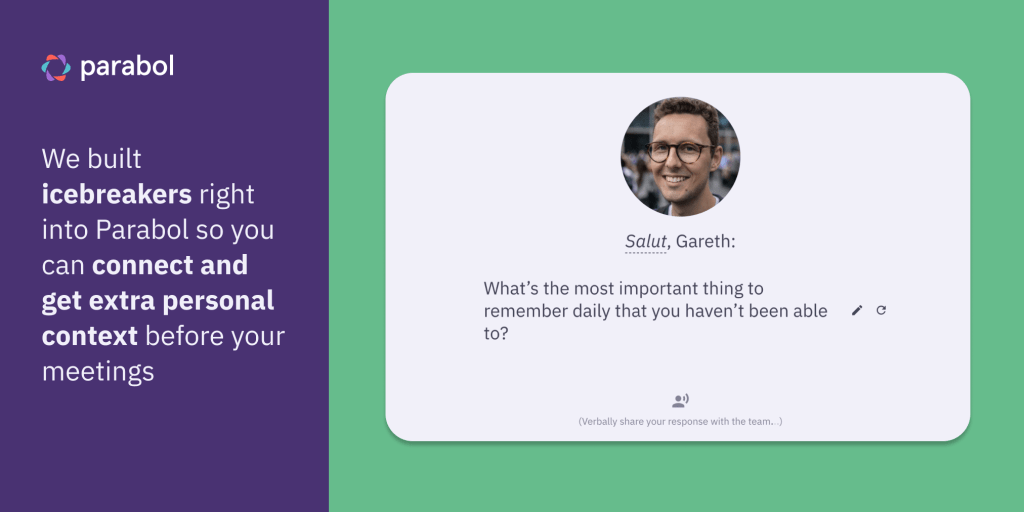Heard Seen Respected (HSR) Template
An activity to build team trust and empathy

What is a Heard, Seen, Respected meeting?
The Heard, Seen, Respected (HSR) exercise is part of the Liberating Structures framework for better teamwork, created by Keith McCandless and Henri Lipmanowicz.
Feeling heard, seen, and respected are the building blocks of good teamwork and communication. To work well together, we need to feel like our ideas are listened to, our contributions are noticed, and other people respect our expertise.
But it’s not always clear what it takes to make other people feel valued and appreciated. And on the flip side, it’s easy to act in a way that doesn’t make people feel good, without even realizing it.
That’s the point of this meeting template. Rather than a typical retrospective, it’s a team activity that will help you practice empathy and understand each other’s perspectives.
By neutrally sharing about times you didn’t feel heard, seen, and respected, you can notice and regain control of your shared communication patterns – especially unwanted patterns you can work to change.
But the point isn’t to fix anything or change anything – it’s to invite participants to share, so the whole group can listen and understand what their experiences were like.
That can help you improve how you navigate tough situations next time.
How to run a Heard Seen Respected (HSR) activity
Are you ready to build team trust and empathy by listening to each others’ stories? There’s plenty of space for positivity in this unique meeting template.
Here are the prompts you’ll need for a Heard Seen Respected (HSR) meeting.
Heard
Think about times, or situations, in which you felt your voice was not heard.
Maybe you had what you felt was a helpful solution to a problem, but others weren’t giving you a chance to properly share. Or maybe you felt uncomfortable with how a situation was being handled, and leadership wasn’t taking your concerns seriously.
What happened? How did it feel?
Example: On my last team, it was really challenging when they decided everyone needed to return to the office full-time. I had very good reasons why my job didn’t need to be done on-site, but no one in charge was interested in hearing them.
Seen
What were some times, or situations, when felt like you weren’t seen, or your efforts weren’t recognized?
Maybe you felt taken for granted in a team environment, and your contributions. Or maybe you felt like teammates never seemed appreciative when you went out of your way to do things for the good of the team.
What happened? How did it feel?
Example: Last December, I worked really hard to host and organize our company holiday party. I’m glad everyone had fun, but I don’t really feel like I got the credit I deserved for pulling that together.
Respected
What about some times or situations when you felt that your boundaries, your contributions, or even you personally were disrespected?
Maybe you felt a coworker dismissed your ideas, implying you didn’t know what you were talking about. Or maybe your boundaries around when, where, how you work were disrespected.
What happened? How did it feel?
Example: In a recent meeting, Jake disagreed with my idea for a new healthcare app feature. But he felt the need to mention he has more experience than me when he did so, which made me feel like he didn’t respect me as a professional.
When to do a Heard, Seen, Respected meeting
On a new team
If you’ve just formed a new team, why not build a strong foundation of communication, trust, and empathy?
This is an ideal activity for new teams, because you can pull on previous situations (unrelated to the current team) where you didn’t feel heard, seen, or respected. You get the same kind of learning within a less sensitive conversation.
After a rough patch
This can be an incredibly valuable exercise if your team has been through some interpersonal challenges, or even a very difficult project that led to high tensions.
It might not always be an easy conversation. But by taking the time to just listen to each others’ experiences, you’ll all come out of it stronger communicators, with a greater culture of empathy and trust.
How to run a Heard, Seen, Respected meeting in Parabol
Parabol’s retrospective meeting type is a great way to solicit feedback and organize it with your team. Simply sign up for free and use our pre-built Heard Seen Respected template.
First things first, get Parabol for free. Then, when you’re in Parabol hit the add meeting button and choose a “retrospective” meeting.
Select the Heard, Seen, Respected template or build your own version of it
Once you’ve selected “retrospective”, browse through Parabol’s library of 40+ pre-made and customizable retrospective formats. Find the Heard, Seen, Respected template and select it.
You can customize any Parabol template by cloning it. If you want to mix up the pre-built template, be our guest! You can also start your own template from scratch if you want to. This is your meeting that serves your team’s goals, team operations, and team collaboration needs. So customize it!
Start your meeting with an Icebreaker
Every Parabol retrospective begins with an optional icebreaker. This box is checked by default. You don’t have to do one, but we recommend it – especially for remote teams.
If you’re doing an icebreaker, you’ll have a random question to answer. You can refresh it if you want another option, and of course you can create your own if you want.

Brainstorm based on the meeting prompts
After the icebreaker you’ll move on to the reflect stage. This is where your team will do all their ideation and brainstorm in silence using the prompts above.
You can choose to make reflections non-anonymous. But for a sensitive conversation like this, we recommend keeping anonymity on, because it will give you more honest responses to your prompts.
Parabo also gives meeting facilitators the option to timebox this process so you can keep your meeting on track or run it asynchronously.
Reveal what people said and see if themes emerge
Reveal your brainstormed cards and group them into themes. Vote on the most important ones together, and launch a discussion on what should be discussed as part of your meeting.
By voting on the issues people feel strongest about you will develop a prioritized agenda that you can talk through with the team, addressing their top questions, comments, or concerns!
Benefit from free meeting summaries
Parabol will send a summary of the retro when you end the meeting so nobody needs to take notes.
Of course, you can do this team retrospective in person, with a whiteboard or sticky notes. But it’s even easier in Parabol, especially if you’re an asynchronous or distributed team.
If you like this template, you might also like other structured brainstorming activities like the Team Charter retrospective or Questions Comments Concerns.